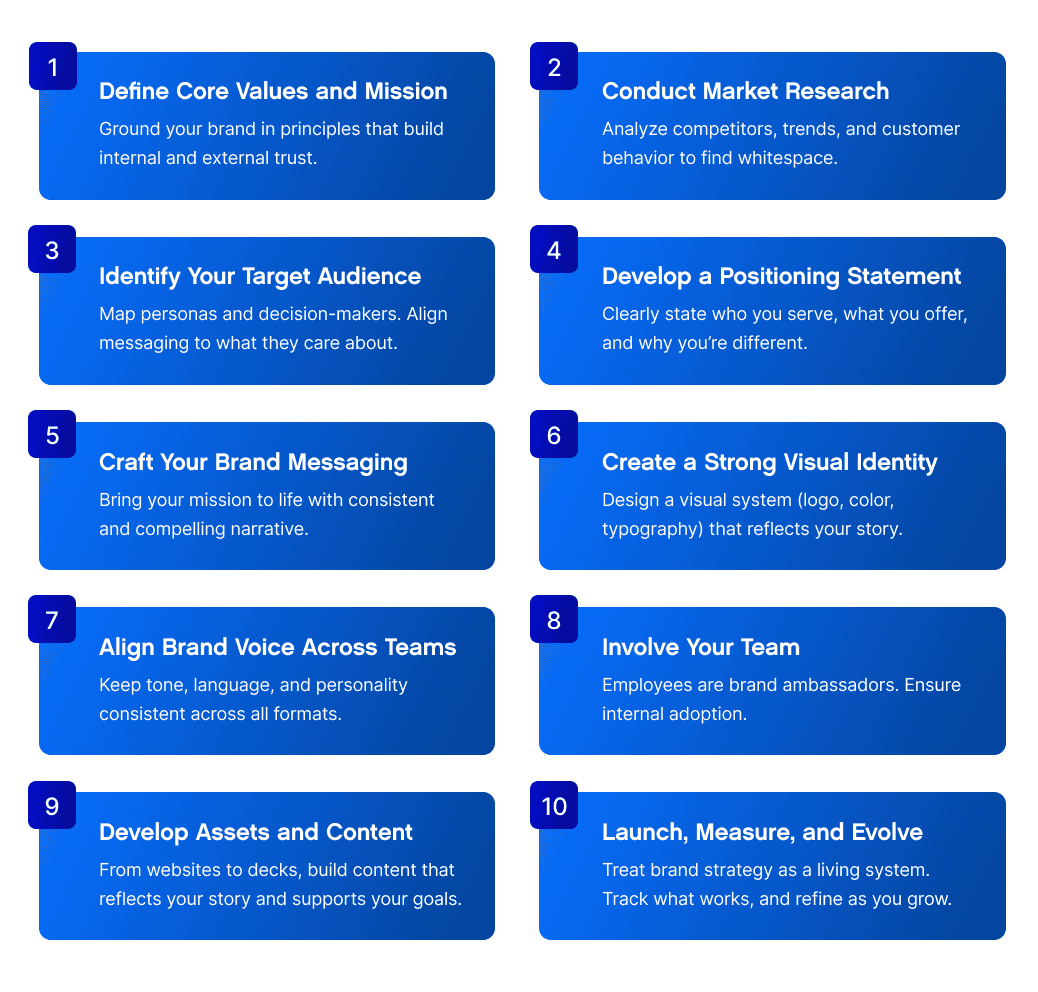
FeaturedBranding
Branding Strategy: The ultimate guide for building a strong brand
In today’s competitive market, brand strategy is far more than just a trendy term—it forms the essential foundation for how your business is perceived, builds trust, and drives growth. A well-crafted brand strategy enhances visibility, aligns internal teams, and generates lasting value. The way people perceive your brand is heavily influenced by the clarity and consistency of your brand strategy. Establishing a strong strategy from the outset is vital, as it lays the groundwork for all successful branding initiatives. To ensure its effectiveness, brand strategy should be informed by market research to align with consumer needs and competition.
At Matic Digital, we’ve seen organizations thrive when they lead with strategy, not just design. When the quick wins fade, brand clarity is what sustains traction. A well-defined brand strategy also helps ensure that company and employee values align, reinforcing consistency across all stakeholder interactions.

Brand Strategy: Definition & guide
What is Brand Strategy?
A brand strategy is a long-term plan that defines how a brand communicates, differentiates, and delivers value to its target audience. It’s more than campaigns or messaging. A true strategy sets the foundation for identity, positioning, and brand voice—creating a unique identity that is aligned with your business goals.
It serves as a roadmap for consistency across all brand touchpoints: from websites and social channels to product experiences, sales decks, and in-person interactions. Understanding your target market is essential when developing a brand strategy, as it ensures your messaging and positioning resonate with the right audience.
An effective brand strategy is crucial for long-term differentiation and success in a competitive market.
Why is Brand Strategy important?
To build recognition, trust, and loyalty, you need more than a clever logo or tagline. Without a clear brand foundation, even the best marketing efforts struggle to resonate or scale. A good brand strategy is essential for long-term business success, helping your company adapt and thrive in a changing market. A clear, memorable brand helps consumers remember and recognize a business, making it a more likely choice when they need a product or service.
A strong brand strategy:
Differentiates your offering in a crowded market
Clarifies your value to internal and external audiences
Attracts potential customers and builds trust with them by communicating your purpose and consistency
Helps attract potential employees by showcasing your company culture and aligning your messaging with core values
Aligns teams across product, sales, and marketing
Creates continuity across platforms and campaigns
The role of Branding Strategy
What is a Branding Strategy?
Branding strategy focuses on managing the elements that make your brand distinct and relatable. That includes your brand story, tone, messaging, and visual identity—all shaped by your values and designed to resonate with your audience. The branding strategy also plays a crucial role in shaping your brand's image in the market, influencing how customers perceive your business. A well-defined brand marketing strategy supports these efforts by establishing your unique market position and ensuring your brand stands out from competitors.
A successful branding strategy ensures consistency, clarity, and connection. Employee involvement is essential in delivering a consistent brand experience, as engaged and well-trained staff help reinforce your brand messaging at every customer touchpoint.
The role of Brand Positioning
Positioning defines how you want to be perceived in your category—and why customers should choose you. It’s the foundation of differentiation. Effective positioning can build on your existing brand to strengthen your market presence and foster customer loyalty. Looking at how other brands approach positioning can reveal different strategies for standing out in a crowded market. Done right, it influences everything from your homepage headline to your sales enablement materials, and it's important to avoid talking about topics that do not align with your brand's positioning to maintain consistency.
A clear positioning statement articulates:

Types of Brand Strategy (and when they matter)
There are four typical brand approaches, and different brand strategies are chosen based on specific business needs and objectives. A well-defined brand development strategy plays a crucial role in selecting the right approach, ensuring alignment with overall business goals and effective market positioning. We help clients choose the right model based on audience complexity, product maturity, and GTM goals:
Individual branding, where each product or service is given its own unique identity to target specific customer segments.
Monolithic branding
Endorsed branding
Hybrid branding
1. Product-Centric Branding
Designed to elevate a specific product or solution in a crowded category, product-centric branding helps create a unique identity for a product or service. Great for companies with one hero product or those entering a competitive space.

Hive Science needed to clarify its B2B2C offering in the health science space. Matic developed a product-forward identity and message architecture that brought clarity and differentiation, ensuring each product or service stands out. The branding approach can also be tailored to connect with audiences who value a healthy lifestyle, aligning messaging and visual identity with wellness-focused market segments.
2. Corporate or Platform Branding
Best suited for companies with multiple offerings or a broader platform strategy. This unifies the story across product lines.

We worked with Pluto Bio to reposition them as a scalable, enterprise-grade platform for life sciences clients. This platform branding approach not only resonated with pharma buyers but also helped Pluto Bio attract new customers in the life sciences sector.
3. Service-Led Branding
Essential for companies selling expertise, outcomes, or recurring delivery models. Often focused on trust, proof, and client experience.

Nourished RX’s brand emphasized outcomes and partnership credibility, helping them close funding and key B2B2C partnerships. The brand strategy was specifically tailored to address the needs and preferences of their target clients, ensuring messaging and services resonated with their intended audience.
4. Challenger Brand Creation
Sometimes the goal isn’t to extend or clarify—it’s to invent. For emerging companies or new GTM plays, strategy needs to be built from zero.
Pulse Fitness wasn’t just a personal brand; it was a new category challenger. Matic created the brand, GTM narrative, and early-stage toolkit in just four weeks to validate and fundraise. A targeted marketing campaign was launched to support the brand’s positioning and connect with its intended audience, helping Pulse Fitness quickly gain traction in the market.
Crafting a Compelling Brand Story
Crafting a compelling brand story is an essential part of a comprehensive brand strategy. Your brand story is more than just a timeline or a list of achievements—it’s the narrative that expresses what makes your brand unique and why it matters to your target audience. A strong brand story weaves together your brand’s experience, values, and mission, creating an emotional connection that sets you apart from competitors.
A well-crafted brand story enhances brand recall and drives brand recognition by helping customers perceive your brand as authentic and relatable. It’s about creating a narrative that resonates with your target customers, builds trust, and reinforces your brand identity at every touchpoint. By incorporating your brand’s personality and core values, your story becomes a powerful tool for establishing a strong brand identity and increasing brand equity.
Ultimately, a compelling brand story is not just an essential part of your brand—it’s the foundation for how your audience remembers and relates to you, ensuring your brand stands out in a crowded marketplace.
Building a Strong Brand Identity
Building a strong brand identity is a crucial part of a successful brand strategy. Your brand identity is the visual and emotional representation of your brand, encompassing everything from your logo and color palette to the typography and imagery you use. A strong brand identity should be instantly recognizable, memorable, and consistent across all marketing materials and channels.
To achieve this, it’s important to document your visual identity in a comprehensive style guide. This ensures that every piece of content, from your website to your social media posts, reflects the same look and feel. Using design tools and templates can help maintain this consistency, making it easier to create marketing materials that capture your brand’s essence and connect with your target audience. Consistent presentation across platforms can increase revenue by up to 23%, highlighting the importance of maintaining a cohesive visual identity.
A strong brand identity is vital for building brand recognition, establishing trust, and supporting business growth. When your visual identity is cohesive and aligned with your brand’s purpose and values, you lay the groundwork for a successful brand that stands out and endures.
Creating a Unique Brand Personality
Creating a unique brand personality is an essential aspect of a comprehensive brand strategy. Your brand personality is the set of human traits and characteristics that your brand embodies, reflected in your tone, language, and overall brand voice. It should be shaped by your brand’s values and mission, and consistently expressed across all marketing channels.
Understanding your target audience is key to developing a brand personality that resonates. By aligning your brand’s personality with the preferences and aspirations of your target audience, you foster deeper emotional connections and set your brand apart from competitors. Whether your brand is playful, authoritative, innovative, or caring, a well-defined personality helps create a strong brand identity and encourages loyalty. Your brand's voice is its overall personality, and tone refers to variations in messaging based on context.
Consistent use of language, imagery, and tone that reflect your brand personality ensures your brand voice is recognizable and engaging. This not only strengthens your brand identity but also supports the long-term growth and success of your brand.
Effective Brand Messaging
Effective brand messaging is a critical component of a successful brand strategy. It involves creating a compelling message that speaks directly to your target audience, builds trust, and drives brand recognition. Your brand messaging should clearly communicate your brand’s purpose, values, and personality, and remain consistent across all marketing channels. Establishing a clear target audience is essential for creating an effective business strategy that leads to a higher return on investment (ROI).
To craft effective brand messaging, start by understanding your target audience’s needs, desires, and challenges. Use storytelling techniques, emotional appeals, and straightforward language to create messages that capture attention and inspire action. Consistency is key—every touchpoint, from your website to your social media, should reinforce the same core message.
A well-crafted brand message not only establishes a strong brand identity but also helps build trust and drive business growth. By ensuring your messaging is relevant and resonant, you lay the foundation for a successful brand that stands out in the minds of your audience.
Making a Brand Promise
Making a brand promise is an essential part of a comprehensive brand strategy. Your brand promise is a clear statement of what your brand stands for, what it offers, and what customers can expect every time they interact with you. It’s a commitment to your target audience that reflects your brand’s values, mission, and personality.
A strong brand promise should be unique, meaningful, and consistently communicated across all marketing channels. It sets expectations and helps differentiate your brand in the marketplace. By delivering on your brand promise, you build trust, foster loyalty, and drive brand recognition—key ingredients for a strong brand identity.
Keeping your brand promise is vital for maintaining credibility and nurturing long-term relationships with your target audience. When your brand consistently lives up to its promise, you create a successful brand that inspires advocacy and supports sustainable growth. The 10 moves that build a scalable brand
We guide clients through these key steps:

Source: Matic Digital
Key elements that define a brand strategy
Brand Identity: Logo, typography, colors, design system
Brand Voice: How you speak across all content
Brand Promise: The value you consistently deliver
Brand Personality: The traits that make you relatable
Positioning Statement: Your unique place in the market
Brand Equity: The commercial value of your brand's reputation

Stay Consistent Continuity builds familiarity and trust.
Foster Loyalty Through Values Customers support brands that reflect their own beliefs.
Engage Employees Your people bring your brand to life.
Tailor Messaging to Segments Speak to real needs, not just personas.
Use Storytelling + Proof Points Combine emotion and evidence.
Leverage SEO + Social Visibility matters.
Measure What Matters Set KPIs for engagement, recognition, and retention.
Brand Strategy in action: Matic Digital work
We build brand systems that help clients grow—not just look better—by driving successful marketing outcomes through strategic planning and innovative campaigns.

Brand Strategy vs. Marketing Strategy
Your brand strategy informs your marketing. While making money is important, brand strategy goes beyond that by focusing on long-term value and a clear sense of purpose. Marketing is how you activate.

A cohesive brand ensures every campaign, post, and deck reflects the same story.
From Brand Development to Long-Term Growth
Strong brands evolve. A great launch is only the start. As you grow, your strategy should scale with you—supporting new products, audiences, and markets. Establishing thought leadership on your website and marketing channels is essential for long-term brand growth, as it positions your company as an industry authority and enhances your reputation.
Aligning brand with business strategy is what keeps your GTM engine efficient and your narrative clear.

About Matic
We're a B2B transformation agency creating strategic advantage through branding, websites, and digital products.
Closing thoughts
Let’s Build a Brand That Performs
Whether you're scaling your presence, repositioning your product, or launching something new, your brand should work as hard as your team does.
Matic helps teams align identity, story, and experience—backed by research, design, and real outcomes.
Ready to build a brand with impact? Contact Matic to start the conversation.


